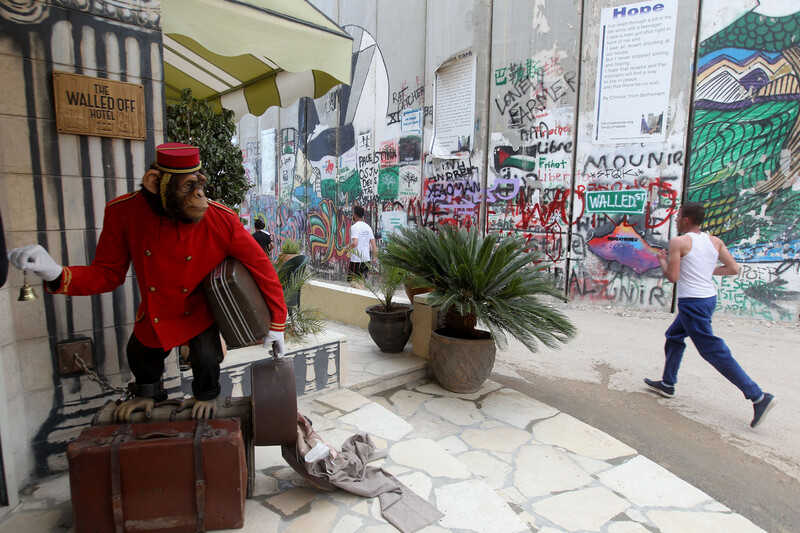Media Watch 24 April 2017

The New York Times misreports location of illegal Israeli-built wall, most of which is inside the occupied West Bank, not on the 1967 boundary line.
APA imagesThe New York Times responded swiftly to pressure last week from Israel and its supporters.
When the paper published an opinion piece about the new hunger strike by Palestinian prisoners, “a rash of readers” objected, according to Liz Spayd, its public editor – who insulted with her word choice even as she backed their case.
The readers were angered, she suggested, by a “distorted characterization” of Marwan Barghouti, the article’s author.
When the piece was originally published online a week ago Sunday, Barghouti was described at the end as a “Palestinian leader and parliamentarian.” After complaints, an editor’s note was appended the following day, stating that Barghouti had been convicted in an Israeli court on “five counts of murder and membership of a terrorist organization.”
Of course, the Times never adds such caveats regarding Israeli leaders who write for the newspaper, even when war crimes they oversaw are detailed by the UN or human rights organizations – perhaps because the international impunity they enjoy means that their Palestinian victims never have their day in court.
It’s far easier for the paper to cite convictions in the colonizer’s courts than to highlight the misdeeds of powerful war criminals who evade justice.
Endless debate?
By contrast with its swift reaction to the Barghouti op-ed, the paper has still not corrected a clear error of fact about Israel’s wall in the occupied West Bank to which I alerted it last month.
The error was contained in an article by Russell Goldman on The Walled Off Hotel, a project by the British graffiti artist Banksy.
According to Goldman, the windows of that “nine-room guesthouse” in Bethlehem “overlook the barrier that separates the territory [the West Bank] from Israel.”
That is plainly wrong. The wall – or “barrier” – is not built along the 1967 boundary between present-day Israel and the West Bank (including East Jerusalem). Rather, it penetrates deep into the West Bank, cutting Palestinians off from their land.
Overall, some 85 percent of the wall extends into the West Bank.
I wrote to the paper several times in March seeking a correction. Beyond automated emails, I got no response.
Both the public editor and the foreign desk ignored me.
Another article about Banksy’s hotel that the Times published in April was also misleading.
Ian Fisher, author of that article, described the wall as an “ugly 26-foot symbol of all that separates Israelis from Palestinians.”
Once again, the Times was implying that the wall separates Israel from the West Bank. Vital context on Israel’s policies of colonization were omitted by Fisher, the paper’s latest bureau chief in Jerusalem.
Fisher adds that the wall has been “endlessly debated.” Part of the debate, he suggests, is whether it constitutes a prison for Palestinians, a “security measure that worked” or even “400 miles of proof of the failure of negotiations.”
He doesn’t mention that despite its land grabs of Palestinian territory, long stretches of the wall have not been completed, or that the end of suicide bombings in Israeli cities can better be explained by Palestinian factions’ abandonment of the tactic.
Fisher also neglects to mention that the International Court of Justice ruled the wall illegal back in 2004.
Repeated corrections
The reticence I have encountered from The New York Times lately appears to be new.
I have been in contact with that paper for many years. Its journalists and editors have repeatedly corrected articles at my urging.
They have generally been prompt. But they have not always been gracious.
In a May 2003 telephone conversation, a New York Times editor, Bill Borders, called me “obdurate” and “bull-headed” for having the temerity to argue that a former colleague of mine, Dr. Fadel Abu Hein, had been arrested by the Israelis rather than allowed to leave the scene of fighting – in which he did not participate – “unharmed.”
Weeks later, the newspaper ran a new article that updated his status by asserting, “A prominent Palestinian psychologist who was detained after Israeli troops razed his family home and killed three of his brothers who were Hamas militants has pleaded not guilty to charges of weapons possession and incitement, his family said.” So, the newspaper admitted he was detained, but did not report precisely when this occurred.
At best, this was an implicit admission of having got the story wrong the first time.
The uneven response by the news media matters because Americans are more likely to be aware of – and oppose – Israeli expansionism if they are given accurate information.
Almost 15 years ago, I wrote about how The New York Times was misinforming its readers on basic details regarding the Middle East.
In 2005, the Times’ then public editor Daniel Okrent agreed with my suggestion that the paper’s reporting was too focused on an Israeli perspective.
But the paper is still flunking geography today.





Comments
apartheid wall
Permalink karen replied on
if the wall is intended to physically separate settlers - their settlements, roads, bus stops, military zones, vehicles, etc - from the native population of Palestine, then it is impossible to complete. The NYT should be shown a map with lines drawn that would technically 'separate Israelis from Palestinians'. The apartheid wall doesn't even come close.
What the apartheid wall does delineate is an imaginary border, mostly between Palestinians themselves.